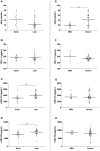Soluble endoglin, transforming growth factor-Beta 1 and soluble tumor necrosis factor alpha receptors in different clinical manifestations of preeclampsia
- PMID: 24851923
- PMCID: PMC4031102
- DOI: 10.1371/journal.pone.0097632
Soluble endoglin, transforming growth factor-Beta 1 and soluble tumor necrosis factor alpha receptors in different clinical manifestations of preeclampsia
Abstract
Background: Despite intensive research, the etiopathogenesis of preeclampsia (PE) remains uncertain. Inflammatory and angiogenic factors are thought to play considerable roles in this disease. The objective of this study was to investigate the association between soluble endoglin (sEng), transforming growth factor beta-1 (TGF-β1) and tumor necrosis factor alpha soluble receptors (sTNF-Rs) and the clinical manifestations of PE.
Methods: Plasma levels of sEng, TGF-β1 and sTNF-Rs were determined by ELISA in 23 non-pregnant, 21 normotensive pregnant and 43 PE women. PE women were stratified into subgroups according to the severity [mild (n = 12) and severe (n = 31)] and onset-time of the disease [early (n = 19) and late (n = 24)].
Results: Pregnancy was associated with higher levels of sEng, sTNF-R1 and sTNF-R2 than the non-pregnant state. Moreover, PE women had higher levels of sEng and sTNF-R1 than normotensive pregnant women. No difference was found in TGF-β1 levels, comparing the three study groups. Late PE had higher levels of sTNF-R1 and sTNF-R2 than early PE. No significant differences were found in sEng and TGF-β1 comparing early and late PE. sEng levels were higher in severe PE than in mild PE and no difference was found for TGF-β1, sTNF-R1 and sTNF-R2 levels. There was a positive correlation among sEng, TNF-R1 and sTNF-2 levels. Logistic regression analysis revealed that primiparity and sEng levels are independently associated with the development of PE. Furthermore, sEng levels are independently associated with the disease severity.
Conclusions: These results suggest that pregnancy is a condition associated with higher levels of anti-angiogenic and pro-inflammatory factors than the non-pregnant state and that PE is associated with an imbalance of these factors in the maternal circulation.
Conflict of interest statement
Figures




Similar articles
-
Soluble endoglin and transforming growth factor-beta1 in women who subsequently developed preeclampsia.Prenat Diagn. 2009 May;29(5):471-6. doi: 10.1002/pd.2217. Prenat Diagn. 2009. PMID: 19253312
-
Multiple Soluble TGF-β Receptors in Addition to Soluble Endoglin Are Elevated in Preeclamptic Serum and They Synergistically Inhibit TGF-β Signaling.J Clin Endocrinol Metab. 2017 Aug 1;102(8):3065-3074. doi: 10.1210/jc.2017-01150. J Clin Endocrinol Metab. 2017. PMID: 28633389 Free PMC article.
-
Late-onset preeclampsia is associated with an imbalance of angiogenic and anti-angiogenic factors in patients with and without placental lesions consistent with maternal underperfusion.J Matern Fetal Neonatal Med. 2012 May;25(5):498-507. doi: 10.3109/14767058.2011.591461. Epub 2011 Aug 25. J Matern Fetal Neonatal Med. 2012. PMID: 21867402 Free PMC article.
-
Angiogenic factors and preeclampsia.Front Biosci. 2007 Jan 1;12:2395-402. doi: 10.2741/2241. Front Biosci. 2007. PMID: 17127249 Review.
-
The role of endoglin and its soluble form in pathogenesis of preeclampsia.Mol Cell Biochem. 2022 Feb;477(2):479-491. doi: 10.1007/s11010-021-04294-z. Epub 2021 Nov 16. Mol Cell Biochem. 2022. PMID: 34783962 Review.
Cited by
-
Resolution of inflammation pathways in preeclampsia-a narrative review.Immunol Res. 2017 Aug;65(4):774-789. doi: 10.1007/s12026-017-8921-3. Immunol Res. 2017. PMID: 28391374 Review.
-
The diagnosis values of serum STAT4 and sEng in preeclampsia.J Clin Lab Anal. 2020 Feb;34(2):e23073. doi: 10.1002/jcla.23073. Epub 2019 Oct 19. J Clin Lab Anal. 2020. PMID: 31628681 Free PMC article.
-
Serum biomarkers for the prediction and diagnosis of preeclampsia: A meta-analysis.J Taibah Univ Med Sci. 2021 Aug 11;17(1):14-27. doi: 10.1016/j.jtumed.2021.07.003. eCollection 2022 Feb. J Taibah Univ Med Sci. 2021. PMID: 35140561 Free PMC article.
-
Molecular determinants of microvascular dysfunction in hypertensive pregnancy and preeclampsia.Microcirculation. 2018 Oct 19:e12508. doi: 10.1111/micc.12508. Online ahead of print. Microcirculation. 2018. PMID: 30338879 Free PMC article.
-
Angiogenesis, Lymphangiogenesis, and the Immune Response in South African Preeclamptic Women Receiving HAART.Int J Mol Sci. 2019 Jul 30;20(15):3728. doi: 10.3390/ijms20153728. Int J Mol Sci. 2019. PMID: 31366152 Free PMC article. Review.
References
-
- Schroeder BM (2002) ACOG practice bulletin on diagnosing and managing preeclampsia and eclampsia. American College of Obstetricians and Gynecologists. Am Fam Physician 66: 330–331. - PubMed
-
- Dekker GA, de Vries JI, Doelitzsch PM, Huijgens PC, von Blomberg BM, et al. (1995) Underlying disorders associated with severe early-onset preeclampsia. Am J Obstet Gynecol 173: 1042–1048. - PubMed
-
- Sibai BM (2008) Maternal and uteroplacental hemodynamics for the classification and prediction of preeclampsia. Hypertension 52: 805–806. - PubMed
-
- Marques FK, Campos FM, Filho OA, Carvalho AT, Dusse LM, et al. (2012) Circulating microparticles in severe preeclampsia. Clin Chim Acta 414: 253–258. - PubMed
Publication types
MeSH terms
Substances
LinkOut - more resources
Full Text Sources
Other Literature Sources

